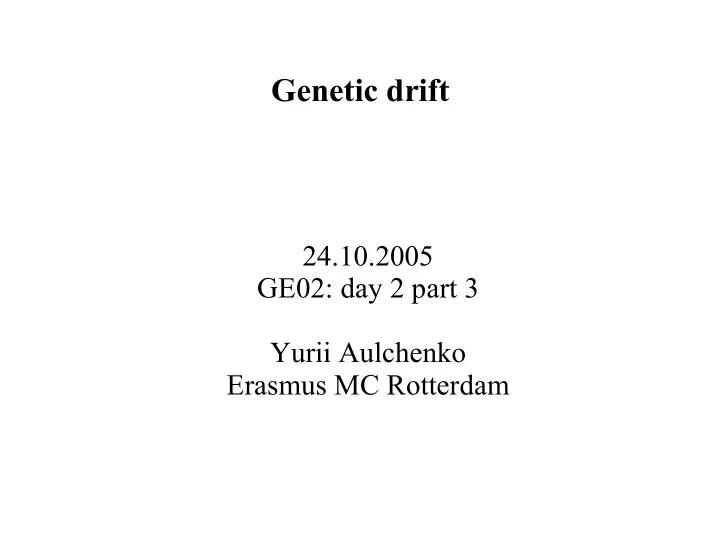

Genetic drift 24.10.2005 GE02: day 2 part 3 Yurii Aulchenko Erasmus MC Rotterdam
Simple genetic population ● Model – There is a population of n individuals (2 n chromosomes) – A very large number of copies is generated fom each chromosomes (gamete pool) – Next generation is obtained by random sampling of 2 n chromosomes from this pool
Problem ● Consider a population of 50 people ● One of chromosomes is mutant ● What is the chance that in the next generation the mutation will – Disappear? – Be still present as single copy? – Increase its’ frequency?
Solution ● Disappear? – P(0 copies M) = 0.99 100 = 0.366 ● Be still present as single copy? – P(1 copy M) = 100 0.01 0.99 99 = 0.37 ● Increase its’ frequency? – P(≥2 copies M) = 1 – P(0 copies) – P(1 copy) = 1 – 0.366 – 0.37 = 0.264
Drift ● In finite genetic populations allelic frequencies are subject to drift (random changes) because of sampling. Drift may occur because of – Small population size – Bottleneck effect ● A large population is reduced very much in size at certain stage – Founder effects ● A small group of founders is sampled from large population to start new one
Bottleneck / Founder effect ● In a population, mutations of some gene are present with frequencies 0.001 (M1), 0.003 (M2) and 0.005 (M3) ● Due to bottleneck or founder effect, the population is reduced to 50 people (100 chromosomes) ● What is the chance that none of these mutations will be present in founders of the new population? ● What is the chance that all 3 mutations will be presents?
Solution ● What is the chance that none of these mutations will be present in founders of the new population? (1 – 0.001 – 0.003 – 0.005) 100 = 0.405 ● What is the chance that all 3 mutations will be presents? Approximate P(M 1 ≥1 & M 2 ≥1 & M 3 ≥1) by P(M 1 ≥1) P(M 2 ≥1) P(M 3 ≥1) P(M 1 ≥1) P(M 2 ≥1) P(M 3 ≥1) = 0.095 0.26 0.394 = 0.01
Very small population ● Consider a “population” made of a single self- pollinating plant ● Initially, the plant is heterozygous (genotype AB)
Task ● What is chance that it will be heterozygous in – First generation – 10 th generation – n- th generation ● After infinite number of generations, what genotypes will be present in the population?
Answer ● What is chance that it will be heterozygous in – First generation – (½) – 10 th generation – (½) 10 = 1/1024 – n- th generation – (½) n ● After infinite number of generations, what genotypes will be present in the population? ● When n ∞ then (½) n 0 therefore only AA or BB may be present, with equal chance of ½
Drift ● A population made of 2 n chromosomes ● k of these are “mutant” (M) and 2 n – k are “normal” (N). Thus the initial frequency of mutant allele is p = k /2 n ● After infinite number of generations, probability that – Both types are present is 0 – Only M are present is k /2 n = p – Only N are present is (2 n – k )/2 n = 1 – p ● Expected number of generations before allele is lost is – [2 k log e ( p )] / (1 – p ) (if p = 1/2n then 2 log e (2 n )) ● Expected number of generations before allele is fixed is – [4 n (1 – p ) log e (1 – p )] / p ( if p = 1/2n then 4 n )
Drift for 18 chromosomes over 19 generations
Effective number ● The number discussed above does not directly relate to number of people in a population ● n is a so-called “effective” number, it is always smaller then real population size
Recommend
More recommend